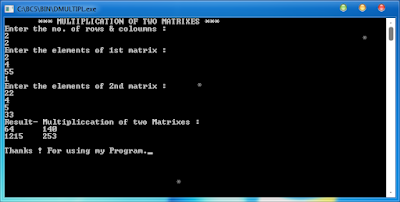#include<stdio.h>
#include<conio.h>
int header();
int sum; /* This is a global variable */
int main( )
{
int index;
header(); /* This calls the function named header */
for (index = 1;index <= 7;index++)
square(index); /* This calls the square function */
ending();
getch(); /* This calls the ending function */
}
header() /* This is the function named header */
{
sum = 0; /* initialize the variable "sum" */
printf("This is the header for the square program\n\n");
}
square(number) /* This is the square function */
int number;
{
int numsq;
numsq = number * number; /* This produces the square */
sum += numsq;
printf("The square of %d is %d\n",number,numsq);
}
ending() /* This is the ending function */
{
printf("\nThe sum of the squares is %d\n",sum);
}
int header();
int sum; /* This is a global variable */
int main( )
{
int index;
header(); /* This calls the function named header */
for (index = 1;index <= 7;index++)
square(index); /* This calls the square function */
ending();
getch(); /* This calls the ending function */
}
header() /* This is the function named header */
{
sum = 0; /* initialize the variable "sum" */
printf("This is the header for the square program\n\n");
}
square(number) /* This is the square function */
int number;
{
int numsq;
numsq = number * number; /* This produces the square */
sum += numsq;
printf("The square of %d is %d\n",number,numsq);
}
ending() /* This is the ending function */
{
printf("\nThe sum of the squares is %d\n",sum);
}







